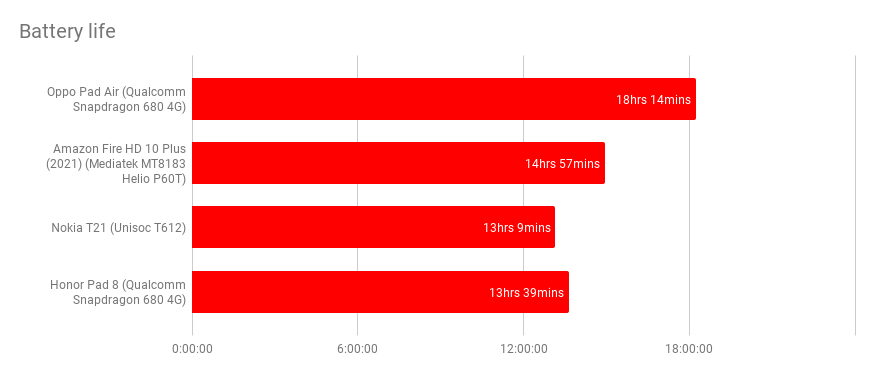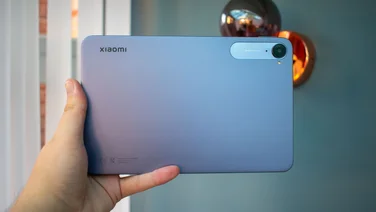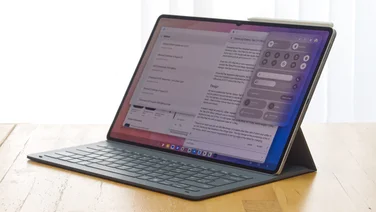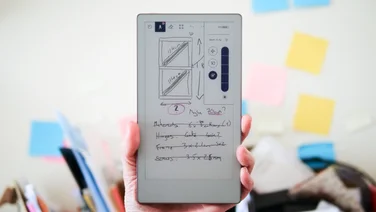To help us provide you with free impartial advice, we may earn a commission if you buy through links on our site. Learn more











- Light but sturdy
- Vibrant 2K display
- Terrific battery life
- Middling colour accuracy
- Not the brightest display
- No keyboard and stylus bundle
The Oppo Pad Air isn’t the Chinese brand’s first swing at making a tablet but it is the first to make its way to UK shores and it enters into a slice of the market that’s dominated by Amazon’s range of affordable Fire tablets, and overshadowed by the entry-level Apple iPad (2021).
READ NEXT: Best tablet
While the Oppo Pad Air doesn’t offer enough to thoroughly bat away all the competition, there’s a lot to like here, especially for those put off by Amazon’s reduced app selection compared with other Android tablets. The incredibly light build lives up to the Air name, battery life is fantastic, and the balance between cost and performance is the best you can get in this price bracket.
Oppo Pad Air review: What do you get for the money?
The Oppo Pad Air retailed for £239 at launch but had been reduced to £209 by the time I got around to writing this review. This slots it in between the two top-end Amazon Fire tablets – the Fire HD 10 Plus (£190) and the Fire Max 11 (£250) – and places it in competition with other budget Android tablets such as the Nokia T21 (£200) and Honor Pad 8 (£270 at launch, but currently down to £180).
That’s some stiff competition, but the Pad Air manages to stand out as the lightest of the bunch, weighing an airy 440g. It isn’t a completely fair comparison to weigh the Pad Air against the larger Honor Pad 8 and Fire Max 11 but it’s still a good deal lighter than fellow 10in tablets Nokia T21 and Amazon Fire HD 10 Plus (466g and 468g, respectively). The Oppo Pad Air is also impressively thin, with its 245 x 155mm frame measuring just 6.9mm thick, tying with the Honor Pad 8 for the thinnest tablet here.
Under the hood, the Oppo Pad Air packs quite a punch for the price. It uses an octa-core 2.4GHz Qualcomm Snapdragon 480 processor, backed up by 4GB of RAM and 64GB of storage, with a microSD card slot for expansion. And it has a surprisingly high-capacity battery, too, coming in at 7,100mAh – the same size as its larger rival, the 12in Honor Pad 8.











As for the display, the specifications are equally impressive; the 10.36in IPS LCD panel matches the specs of both the Honor and Nokia models with a crisp 2K resolution (2,000 x 1,200) and a maximum refresh rate of 60Hz. This is surrounded by reasonably slim bezels, creating a screen-to-body ratio of around 83.5%, while a 5MP selfie camera sits beneath one of the long bezels. This camera can also be used for face unlocking, which is a handy inclusion as there is no fingerprint sensor.
Flip over the tablet and you’ll find the other camera, a serviceable 8MP affair, set into a thin textured plastic panel that runs the length of the rear of the tablet. While you can opt to wrap the tablet in Oppo’s official flip cover (£30), that is the extent of peripherals on offer. There’s no keyboard case and, although the tablet does have stylus support, the brand’s own Pencil isn’t currently available for purchase in the UK.
Colour options are also limited in this market to a single, fairly muted grey colour. It may not be the most flashy, but the design is still classy enough to make up for the lack of variety, with the curved corners and flat edges calling to mind the latest Apple iPad.











Finally, around these edges, you’ll find a decent selection of buttons and ports. With the tablet held in landscape orientation and the selfie camera at the top, you’ll find the volume controls and the microSD card slot on the edge just above the camera, the power button high up on the left side and the USB-C charging port central on the right. The left and right edges are also home to the Pad Air’s four 1W speakers (two on each edge) and the tablet delivers support for Dolby Atmos audio content.
READ NEXT: Best ebook reader
Oppo Pad Air review: What did we like about it?
In addition to supporting Dolby Atmos, these four speakers achieve an impressive maximum volume. Even better, they do so without too much compromise on audio quality; on occasion, loud voices come through a bit tinny but it’s infrequent enough to not be irritating. Dolby Atmos support is also a great inclusion, enriching the audio on compatible services with greater stereo separation and audio panning.
You can’t pair the Dolby Atmos with Dolby Vision, unfortunately, or any other HDR format, as these aren’t supported. If you want this feature, the Xiaomi Pad 5 is your best bet here but it costs over £100 more at £349. Even without HDR, though, the Oppo Pad Air looks terrific; the 1,465:1 contrast ratio is on the more impressive end of things – only outdone by the Honor Pad 8’s 1,670:1 – and the measured black level of 0.22cd/m2 is the best of all its main rivals. In short, this is a great choice for streaming TV and movies.











The focus on streaming is clear, as Netflix is one of only a small handful of preinstalled apps on the Pad Air – a welcome change after we criticised the Oppo Find X5 Pro for being weighed down by excessive bloatware. Other than that, the ColorOS 12.1 software, layered over Android 12, is nearly identical to the smartphone version. Productivity features such as the floating windows and split screen work much better with the bigger screen on the Pad Air, though you’re still limited to just one floating window at a time and some apps, like Netflix, don’t support split screen and can only be floating windows.

Although running more intensive apps like Google Maps and Disney Plus side by side may cause a bit of slowdown – the Snapdragon 680 chipset isn’t the most advanced out there – the Pad Air still performed well compared with other tablets in this price range. Despite being paired with a lowly 4GB of RAM, the Oppo kept pace with the pricier Honor Pad 8, and maintained a significant lead over the Nokia T21.

The Oppo’s scores in the GFXBench benchmark of 22fps for the onscreen (native resolution) and 23fps offscreen tests are perfectly serviceable, too, just as long as your gaming aspirations lean more towards Candy Crush than Call of Duty.

The Oppo Pad Air’s best result came in the battery life test, lasting for an outstanding 18hrs 14mins before the battery died. In practical terms, this should easily see you into a second day of moderate use, while anyone who is prone to leaving a tablet untouched for a couple of days, as I did during testing, will find that the battery barely depletes while sitting on standby.
Once the battery is depleted, you can use the provided 18W charger to top it up. In testing, this charger took the battery from empty to 50% in a little over an hour, and on to full in around two-and-a-half hours. The Pad Air also supports 5W reverse charging via USB, allowing you to charge up external devices like a phone or earbuds case on the go. The bundled cable isn’t a double-ended USB-C affair, though, so you’ll need to provide your own to take advantage of this feature.
Oppo Pad Air review: What could be improved?
If you do take the Oppo Pad Air out and about, bear in mind that the Pad Air – like most tablets – lacks an official IP rating for dust and water resistance. There’s also no cellular option, meaning that you’ll have to be tethered to Wi-Fi to make full use of the tablet on the go. If either of these points are deal breakers, the Nokia T21 is a better pick, with the IP52 rating certifying it as dust and splash resistant, and a 4G-enabled model available for £239.
Another reason to exclusively use the Pad Air indoors is that it doesn’t hold up as well to bright sunlight as other devices. The maximum brightness of 331cd/m2 isn’t terrible by any stretch but it is the weakest among its rivals, and is outshone by the Amazon Fire HD 10 Plus (445cd/m2), the Honor Pad 8 (389cd/m2) and even the cheaper Nokia T21 (340cd/m2). I never found the Oppo’s display to be dull during testing but if you’re likely to take your tablet outside a lot, the Honor Pad 8 or Amazon Fire HD 10 Plus will serve you better.











There’s also only one colour mode, and it isn’t the most accurate around – it’s capable of reproducing 93.6% of the sRGB colour space with a lacklustre average Delta E score of 2.4 showing more colour variance than we’d like to see. The cheaper Nokia T21 returned a lower (better) average Delta E of 2.04 and the Honor Pad 8 recorded 1.64. The average user won’t notice any weird colours on the Oppo but anyone who wants to use the tablet for art or graphic design will find the Honor Pad 8 more accurate.
READ NEXT: Best value tablet
Oppo Pad Air review: Should you buy it?
So there are a few flaws here and there in the design but, as a whole, the Oppo Pad Air makes for an impressive Western debut. The build feels robust and looks stylish, the battery life is fantastic and the display is crisp and vibrant, so long as you don’t care too much about pinpoint colour accuracy.
While it doesn’t quite take the crown as our best-value Android tablet, the mere fact that it’s in contention is noteworthy. Especially considering that our current favourites, the Samsung Galaxy Tab S6 Lite and the Xiaomi Pad 5, both cost over £100 more. If that’s too rich for your blood and you’d prefer something under £250, the Oppo Pad Air should float right to the top of your shopping list.







